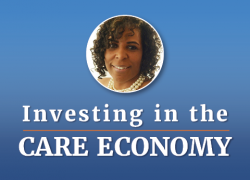 This November, as we honor National Family Caregivers Month, the U.S. Department of Health and Human Services (HHS) and the U.S. Department of Labor are also recognizing the paid workforce that provides essential home- and community-based services to millions of older adults and people with disabilities.
This November, as we honor National Family Caregivers Month, the U.S. Department of Health and Human Services (HHS) and the U.S. Department of Labor are also recognizing the paid workforce that provides essential home- and community-based services to millions of older adults and people with disabilities.
Without access to these critical workers, who are predominantly women, and disproportionately women of color, family caregivers have no choice but to take on more care. These direct care workers include personal care and home health aides, direct support professionals and others who help with self-care and other daily tasks. Their work supports individuals’ ability to work and live in their communities, rather than in institutions.
People may need care at any point in their life. Providing care and services to older adults and people with disabilities is important and often deeply personal work. This assistance can enable the people who need it to live, work, and be fully integrated in all aspects of community life. As policymakers, people with disabilities, older adults, and families continue to push for care in the community, the need for these workers is projected to grow more than any other occupational group.
But despite increasing demand and longstanding workforce shortages, direct care jobs often come with part-time hours, wages lower than other entry-level jobs, few benefits, little access to training, and physically demanding work. As a result, job turnover is high, recruitment and retention are challenging, and many people cannot get the care they need.
President Biden recognized the critical role of home- and community-based service providers when he signed the Executive Order on Increasing Access to High-Quality Care and Supporting Caregivers in April 2023. The Executive Order recognized the need for better data on this workforce to improve their job quality and help inform policies and practices, and tasked HHS and the Labor Department with analyzing existing data and identifying opportunities for improving data and knowledge about the workforce.
Many of the questions pertinent to improving direct care jobs and making informed policy decisions are difficult to answer with the data currently available. Information is often unavailable or incomplete, and much of the data we do have cannot be broken out by state, making it difficult to understand the impact of states’ Medicaid and other policies.
Over the last six months, we have established a workgroup to identify key priorities, review existing data sources, and recommend ways to fill critical gaps in knowledge. This effort has been driven by a focus on policy — what data do we need to support the workforce, meet growing demand, and improve access to high quality services — and how we track the impacts of policy changes over time. Stakeholder input is essential, and we continue to look to consumers and their families, direct care workers, including those providing self-directed care, unions, advocacy and provider organizations, state leaders and other stakeholders to inform our work. The new solutions that are emerging are bold, alongside opportunities to add on to and maximize existing data.
The workgroup – which consists of experts from the Labor Department’s Women’s Bureau, Office of Disability Employment Policy, and Office of the Assistant Secretary for Policy, and experts from HHS’s Office of the Assistant Secretary for Planning and Evaluation, Administration for Community Living, Centers for Medicare and Medicaid Services, Health Resources and Services Administration, National Center for Health Statistics and National Institute on Aging – will release its recommendations in Spring 2024, but that will only be the first step. Investing in care is an investment in the future of America’s families, workforce, and economy. To do so wisely, better data is necessary to improve job quality for home- and community-based service providers and to expand equitable access to services for millions of people with disabilities and older adults.

 U.S. Department of Labor Blog
U.S. Department of Labor Blog


